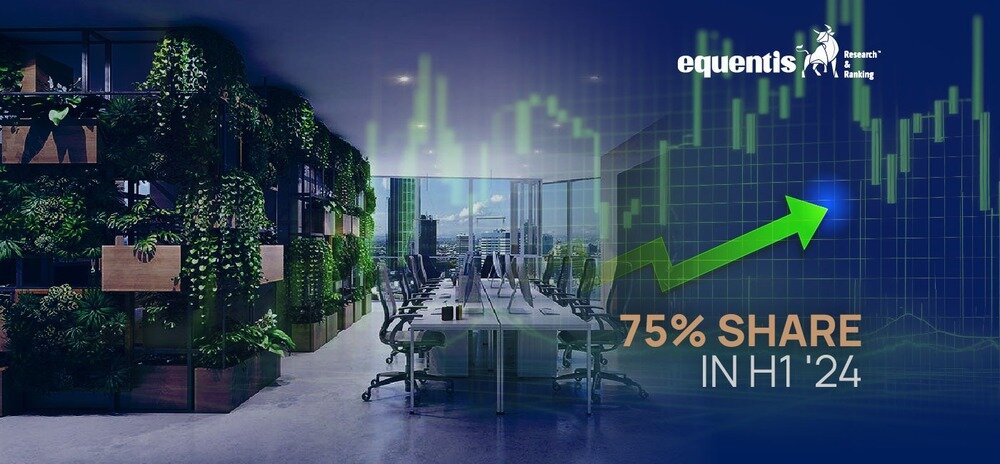Occupier Interest Surges
In India, the real estate landscape is undergoing a significant transformation, with sustainability emerging as a key driver. Green office spaces, characterized by their eco-friendly design and operations, are witnessing a surge in occupier interest. In the first half of 2024, these spaces captured nearly 75% of the total office space leased, underscoring a clear preference for sustainable work environments.
The global Green Buildings Market is projected to be valued at USD 0.59 trillion in 2024 and is expected to grow to USD 1.10 trillion by 2029, with a compound annual growth rate (CAGR) of 10.82% during the forecast period (2024-2029).
Green Buildings Market Size & Forecasts (2024-2029)
The Asia-Pacific green building market is experiencing substantial growth fueled by government initiatives, heightened environmental awareness, and a strong focus on energy efficiency. The region is experiencing increased green building projects, certifications, and sustainable urban development efforts. Additionally, the demand for green buildings is expected to rise further due to the region’s rapidly expanding population and increasing disposable income.
| Study Period | 2020-2029 |
| Market Size (2024) | USD 0.59 Trillion |
| Market Size (2029) | USD 1.10 Trillion |
| CAGR (2024-2029) | 10.82% |
| Fastest Growing Market | Asia Pacific |
| Largest Market | Europe |
India, a key regional player, has also made significant progress in the green building sector. The Indian Green Building Council (IGBC) has played a crucial role in advancing green building practices and certifying sustainable projects. Numerous cities in India have implemented green building codes and regulations, leading to a rising demand for green buildings in both the commercial and residential sectors.
Green Buildings Market Trends Worldwide
- Rising Investment and Demand: There is an increasing investment and growing demand for sustainable buildings, particularly in the commercial sector.
- Corporate Demand Driving Office Markets: Corporate interest in sustainable buildings is expected to shape office market dynamics in major global cities like New York, Paris, and Singapore. However, in the next few years, only 34% of the low-carbon demand is expected to be met, leaving one square meter available for every three square meters currently in demand.
- Changing Perception Among Occupiers: Sustainable buildings alter how tenants perceive them, with green certifications being a key indicator of sustainability. Tenants are willing to pay a premium for these certified buildings.
Key Points Driving the Green Building Boom:
- Increased Demand for Sustainability: Growing demand for sustainable and environmentally responsible spaces drives green building construction.
- Regulatory Pressure: Stricter global and domestic ESG regulations are compelling businesses to focus on sustainability.
- Rising Occupier Demand: Occupiers increasingly seek modern office spaces that meet stringent sustainability standards.
- Industry Shift: The real estate industry is actively integrating green practices into development strategies, with a notable increase in buildings achieving green certifications.
- Investor and Occupier Preferences: Investors and occupiers strongly prefer green-certified projects that emphasize energy efficiency and carbon reduction.
- Innovation in Office Design: Developers are incorporating open layouts, natural light, and energy-efficient technologies to create greener and more modern workspaces.
- Setting New Industry Standards: Developers who prioritize sustainability and obtain certifications like IGBC are establishing new industry benchmarks.
- Convergence of Factors: The combination of regulatory pressures, investor preferences, and occupier demands is accelerating the growth of green buildings, making sustainable construction an emerging industry standard.
Key Cities Leading the Charge
Bengaluru and Mumbai have emerged as the frontrunners in the green office space market. These cities have witnessed a substantial increase in demand from technology, engineering, and manufacturing firms, which are at the forefront of sustainability initiatives. The availability of a robust talent pool and a thriving startup ecosystem in these cities further fuels the demand for green office spaces.
Moreover, government policies and incentives supporting green building development have played a crucial role in accelerating market growth. Various tax benefits, faster approvals, and access to green financing have encouraged developers to invest in sustainable projects.
A Sustainable Future
The trend towards green office spaces is expected to gain further momentum in the coming years. As global sustainability standards become more stringent, developers are aligning their projects with these benchmarks to cater to the evolving needs of occupiers.
Moreover, advancements in green building technologies make constructing sustainable office spaces more cost-effective and efficient. This is expected to accelerate the adoption of green building practices across the real estate industry.
Challenges and Opportunities
While the growth in green office spaces is encouraging, challenges must be addressed.
- The availability of green-certified buildings in tier-II and tier-III cities is still limited. Expanding the green building footprint to these regions is crucial to meet the growing demand.
- Additionally, there is a need for robust certification standards and independent verification processes to ensure the credibility of green building claims.
Despite these challenges, the overall outlook for green office spaces is positive. The growing occupier interest and supportive government policies and technological advancements create a conducive environment for the proliferation of sustainable office buildings.
A Win-Win Proposition
Buildings are responsible for significant global energy use and greenhouse gas emissions. Approximately 25-28% of emissions come from energy use during operation, while 10-11% stem from construction and materials. The International Energy Agency (IEA) highlights that the building sector, including construction, heating, cooling, and lighting, is a major contributor to energy consumption and emissions. Reducing carbon emissions in the construction industry is essential for meeting sustainability goals.
The shift towards green office spaces is a win-win situation for all stakeholders. Businesses benefit from improved operational efficiency, enhanced brand reputation, and access to a skilled talent pool. Employees enjoy healthier and more productive work environments. And the environment reaps the benefits of reduced carbon emissions and resource conservation.
As the world becomes increasingly conscious of its environmental impact, green office spaces are set to become the norm rather than the exception.
*Disclaimer Note: The securities quoted, if any, are for illustration only and are not recommendatory. This article is for education purposes only and shall not be considered as recommendation or investment advice by Research & Ranking. We will not be liable for any losses that may occur. Investment in securities market are subject to market risks. Read all the related documents carefully before investing. Registration granted by SEBI, membership of BASL, and certification from NISM in no way guarantee the performance of the intermediary or provide any assurance of returns to investors.
FAQs
What is driving India’s green office boom?
A confluence of factors is propelling India’s green office boom. First, there’s a growing awareness about climate change and the need for sustainable practices. Second, government initiatives and policies are incentivizing green buildings. Third, corporate social responsibility (CSR) goals are pushing businesses to adopt eco-friendly practices. Lastly, the cost-saving benefits of green buildings, such as reduced energy consumption and improved indoor air quality, are making them an attractive investment.
What are the benefits of green offices for businesses?
Green offices offer numerous benefits to businesses. These include improved employee health and productivity due to better indoor air quality and natural light. Additionally, green buildings often reduce energy consumption, resulting in significant cost savings. Moreover, they enhance a company’s brand image and reputation as an environmentally responsible organization. By adopting green office practices, businesses can contribute to a sustainable future while reaping financial and operational advantages.
How is India contributing to the global green building market?
India is emerging as a significant player in the global green building market. The country has witnessed a surge in green office construction and renovations, contributing to a substantial market share. This rapid growth is driven by a large and growing economy, a young and environmentally conscious population, and a favorable policy environment. India’s leadership in the green building space is expected to continue, with the potential to become a global green building hub.
How useful was this post?
Click on a star to rate it!
Average rating 5 / 5. Vote count: 1
No votes so far! Be the first to rate this post.
waitfor delay '0:0:5'--
I’m Archana R. Chettiar, an experienced content creator with
an affinity for writing on personal finance and other financial content. I
love to write on equity investing, retirement, managing money, and more.
 Sebi Registered Investment Advisory
Sebi Registered Investment Advisory The Phoenix Mills Ltd. (PDF)
The Phoenix Mills Ltd. (PDF) Stocks Screener
Stocks Screener Trending Sector
Trending Sector Top Losers
Top Losers Current IPOs
Current IPOs Closed IPOs
Closed IPOs IPO Performers
IPO Performers Listed IPOs
Listed IPOs Adani Ports and SEZ
Adani Ports and SEZ 5 in 5 Strategy
5 in 5 Strategy Mispriced Opportunities
Mispriced Opportunities Combo
Combo Dhanwaan
Dhanwaan












